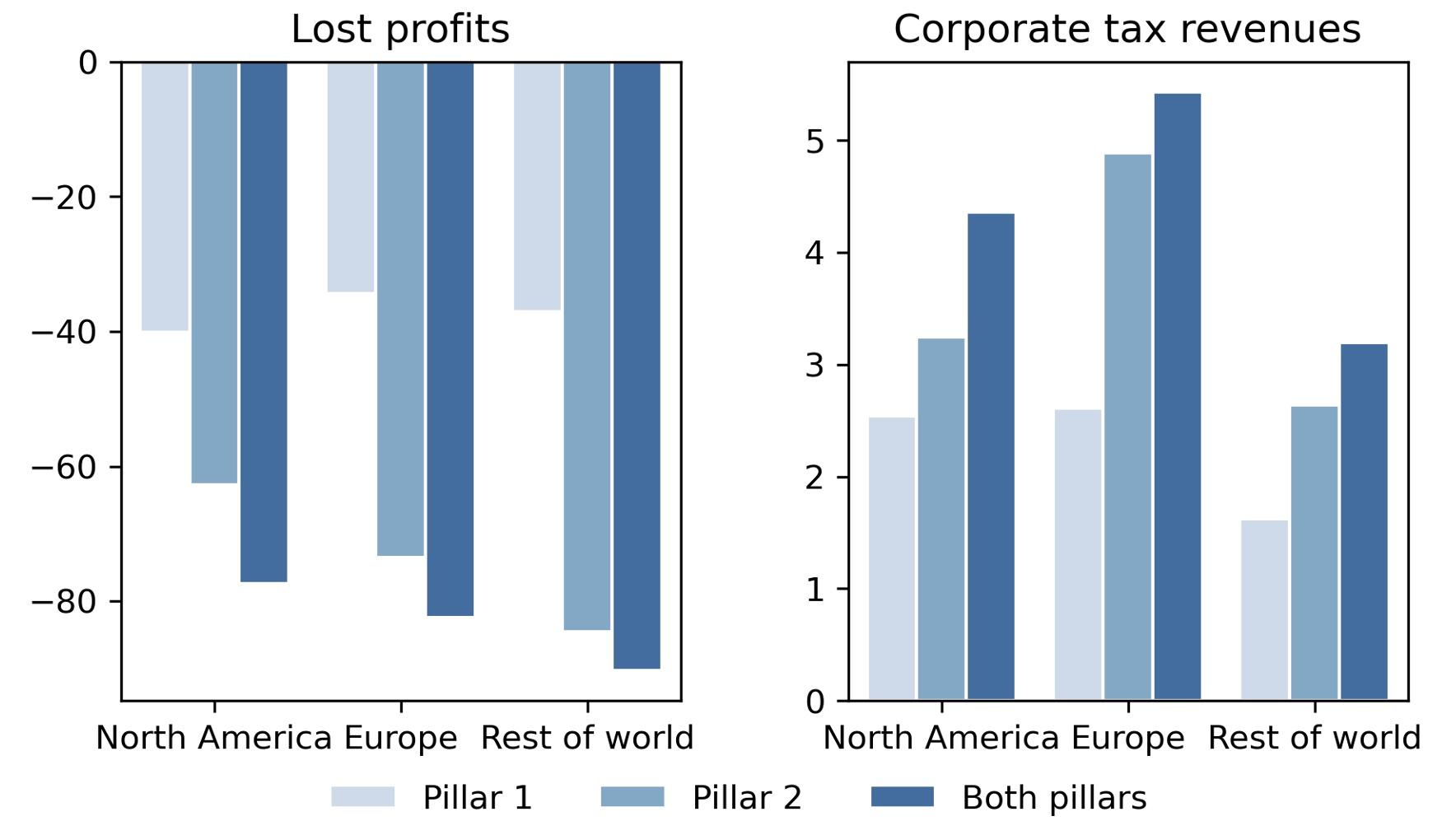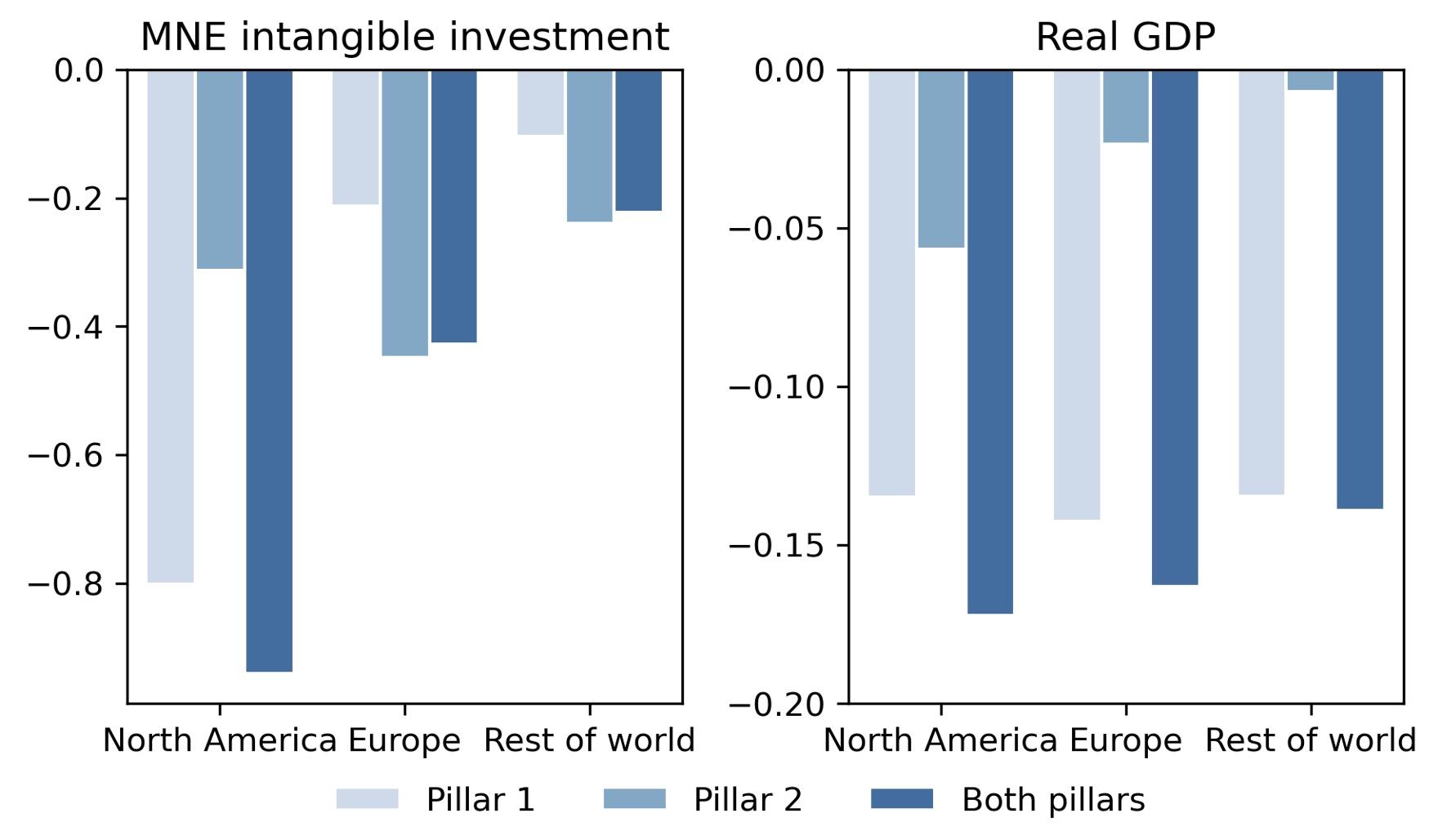International profit shifting by multinational enterprises (MNEs) is one of the most pressing issues facing today’s policymakers. According to Guvenen et al. (2017) and Tørsløv et al. (2018), MNEs shift almost 40% of their profits to tax havens, costing governments in North America, Europe, and other high-tax countries hundreds of billions of dollars in tax revenues each year (see, for example, the OECD’s estimates in Johansson et al. 2017).
In October 2021, 137 countries representing 90% of global GDP signed a landmark international policy agreement designed by the OECD and G20 governments to reduce multinational profit shifting. This agreement, which is the largest international tax reform in history, has two components, or ‘pillars’: a rule that reallocates the rights to tax 25% of a corporation’s profits to the countries in which it sells its products, regardless of the profits it reports in these countries; and a global minimum tax rate on corporate profits of 15% (see OECD (2021) for more details).
This historic reform is likely to reduce profit shifting substantially (see Acciari et al. 2021), but it also has the potential to cause serious macroeconomic side effects. In a recent paper (Dyrda et al. 2022), we develop a new model of profit shifting that we use to illustrate the source of these effects and measure their quantitative significance.
Profit shifting and intangible investment
As described by Neubig and Wunsh-Vincent (2017), the primary way that MNEs shift profits is by selling the rights to intellectual property and other forms of intangible capital to foreign affiliates in tax havens like Ireland and Bermuda at a steep discount below fair market value. These affiliates then collect royalties or licensing fees from other affiliates in high-tax countries that use this capital to produce goods and services. This idea is backed by empirical evidence; for example, Guvenen et al. (2022) and Delis et al. (2021) show that profit shifting is concentrated among firms and industries that have the most intangible capital.
The result of this kind of profit shifting is that the after-tax return on MNEs’ intangible investment rises, making this investment more attractive. Our model of profit shifting is designed to capture exactly this channel, and it shows that an MNE’s optimal level of intangible investment is indeed increasing in the amount of profits that it shifts. And if profit shifting increases MNEs’ intangible investments, then policies like the OECD/G20 framework that are designed to reduce profit shifting will have the opposite effect. Since MNEs play such an outsized role in today’s economy—the average MNE in the US employs almost 500 times as many workers as the average firm overall—this reduction could have a material impact on the economy as a whole. This means that policymakers face a trade-off: on the one hand, regulating profit shifting could increase tax revenues, but on the other, it could cause the economy to contract.
Quantifying the macroeconomic consequences of the OECD/G20 reform
Our model divides the world into three high-tax regions (North America, Europe, and the rest of the world) and a low-tax region comprised of the countries identified as tax havens by Tørsløv et al. (2022). We parameterise the model to reproduce microeconomic and macroeconomic facts about production, trade, foreign direct investment, and, most importantly, the total amount of profits shifted from high-tax regions to low-tax regions. We then use the model to simulate what will happen when the OECD/G20 framework is implemented. To highlight the effects of each of the framework’s two pillars, we simulate their effects both in isolation and together.
Figure 1 shows the effects of these pillars on profit shifting (left side) and corporate tax revenues (right side) in each of our model’s high-tax regions. Pillar 1, the sales-based profit-reallocation rule, would reduce the profits shifted out of North America, Europe, and the rest of the world by 40%, 34%, and 37%, respectively. As a result, corporate tax revenues would rise by 2.5%, 2.6%, and 1.6%. Pillar 2, the global minimum corporate income tax, would have even larger effects. Profit shifting would fall by 63–85% in our model’s high-tax regions, which would increase tax revenues by 2.6–4.9%. When these two pillars are combined, profit shifting would fall by a full 77% in North America, 82% in Europe, and 90% in the rest of the world, and tax revenues would rise by 4.4%, 5.4%, and 3.2%. Clearly, these results show that the OECD/G20 framework would go a long way towards achieving its goal.
Figure 1 Effects of OECD/G20 BEPS framework on profit shifting and tax revenues (measured in percent changes)
Figure 2 shows how the OECD/G20 framework would affect the real economy. The left side of the figure shows how MNEs’ intangible investments would respond to the framework’s two pillars. Both pillars would reduce these investments in all three high-tax regions, but pillar 1 would have particularly severe effects in North America, while pillar 2 would have the largest impact in Europe. The right side of the figure shows the ultimate impact on overall real GDP. Again, both pillars would cause economic contractions, but in this case pillar 1 would have the largest effect in all three regions. This is because of the outsized importance of US-based MNEs in economic activity around the world; pillar 1 would affect US MNEs more than pillar 2, and these MNEs play an important role in other countries’ economies as well. The combined macroeconomic effects of both pillars would be slightly larger than the effects of pillar 1 alone.
Figure 2 Effects of OECD/G20 BEPS framework on intangible investment and GDP (measured in percent changes)
In addition to illustrating the mechanisms underlying the economic effects of profit shifting, our model lays the groundwork for further research on topics such as international tax competition and optimal corporate taxation. Our findings, indicating that the OECD/G20 framework would have adverse macroeconomic side effects, have important implications for policymakers. For example, the fact that pillar 1 (the sales-based profit allocation rule) has less impact on profit shifting but more macroeconomic bite than pillar 2 (the global minimum corporate tax rate) indicates that policymakers should reconsider their approach, or even do away with the first pillar altogether.
References
Acciari, P, B Bratta and V Santomartino (2021), “New patterns of profit shifting emerge from country-by-country data”, VoxEU.org, 28 June.
Delis, F, M Delis, L Laeven and S Ongena (2021), “Global Evidence on Profit Shifting Within Firms and Across Time”, CEPR Discussion Paper No. 16615.
Dyrda, S, G Hong and J B Steinberg (2022), “A Macroeconomic Perspective on Taxing Multinational Enterprises”, University of Toronto Working Paper No. 731.
Guvenen, F, R J Mataloni Jr., D G Rassier and K J Ruhl (2017), “Offshore profits and domestic productivity”, VoxEU.org, 14 June.
Guvenen, F, R J Mataloni Jr., D G Rassier and K J Ruhl (2022), “Offshore Profit Shifting and Aggregate Measurement: Balance of Payments, Foreign Investment, Productivity, and the Labor Share”, American Economic Review 112: 1848–84.
Johansson, A, Ø B Skeie, S Sorbe and C Menon (2017), “Tax planning by multinational firms: Firm-level evidence from a cross-country database”, OECD Economics Department Working Paper No. 1355.
Neubig, T S and S Wunsch-Vincent (2017), “A missing link in the analysis of global value chains: cross-border flows of intangible assets, taxation and related measurement implications”, World Intellectual Property Organization Working Paper No. 37.
OECD (2021), “Statement on a Two-Pillar Solution to Address the Tax Challenges Arising from the Digitalisation of the Economy”, 8 October.
Tørsløv, T, L Wier and G Zucman (2018), “The missing profits of nations”, VoxEU.org, 23 July.
Tørsløv, T, L Wier and G Zucman (2022), “The Missing Profits of Nations”, The Review of Economic Studies, forthcoming.








